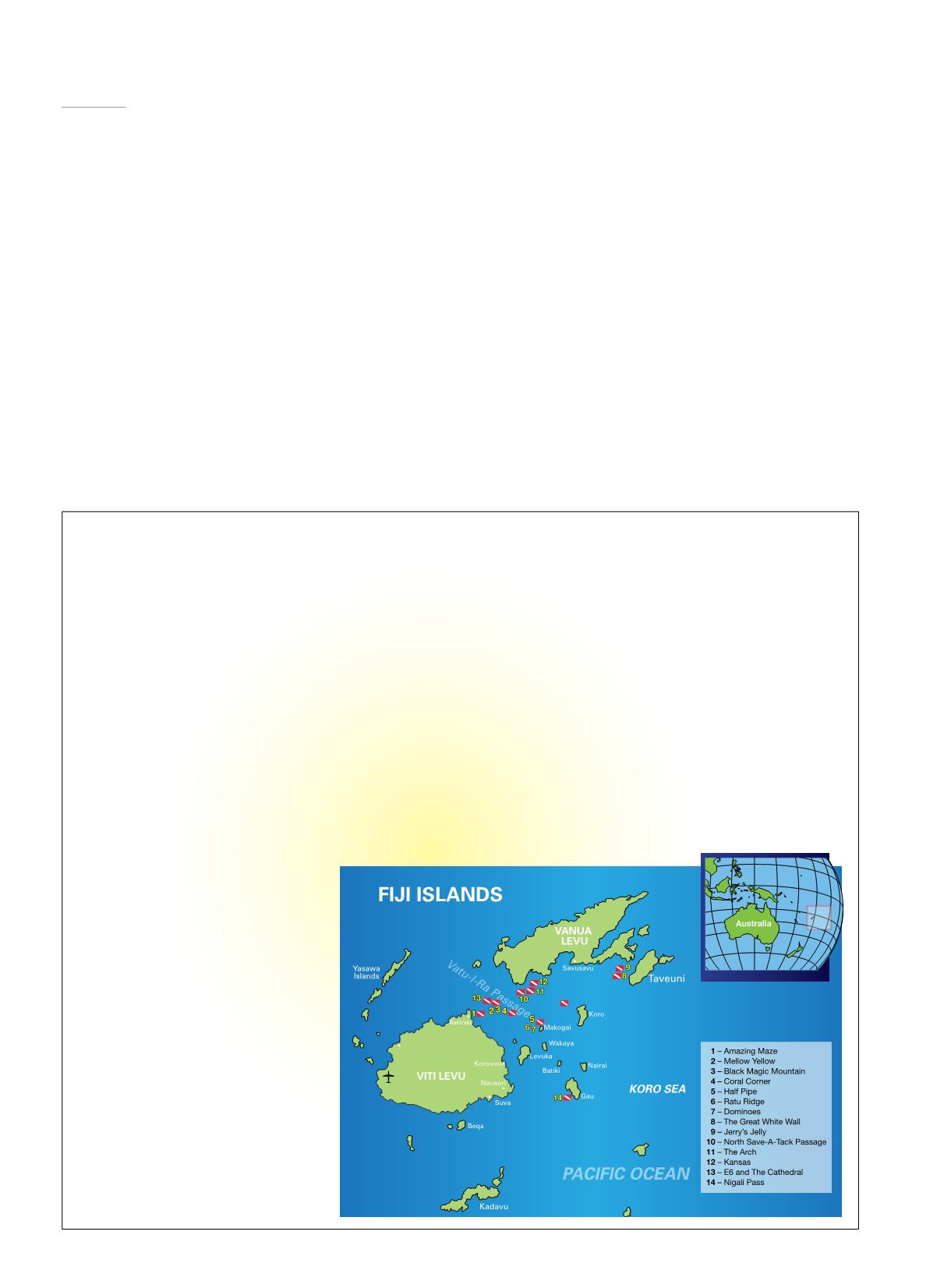

72
|
WINTER 2016
HOW TO DIVE IT
GETTING THERE
Fiji lies in the southwestern Pacific, 1,750
miles northeast of Sydney, Australia. The 333
islands of the archipelago are spread over
80,000 square miles of ocean. The islands of
Viti Levu, Vanua Levu and Taveuni make up
90 percent of the nation’s landmass and are
home to 85 percent of its 880,000 people.
Several airlines offer flights from Los Angeles
to Nadi, including American, Fiji Airways,
Qantas and Air New Zealand.
LAND-BASED OR LIVEABOARD?
Our 2015 itinerary included some sites
accessible only via liveaboard dive boat
because of their distance from shore,
but Fiji has dozens of extraordinary land-
based dive resorts that offer high-quality
diving with daily dive excursions and
sophisticated scuba infrastructure.
WATER TEMPERATURE
Divers are sometimes surprised by how cold
the water is in Fiji at certain times of year.
It’s certainly not frigid, but in September
through November it might drop into the
low- to mid-70s°F. Dress for it, and you’ll
have a wonderful time. In September 2015
the temperature was typically right around
75°F throughout our cruising range. I’ve
been there in February and had 86°F water.
In some months a 3mm wetsuit is plenty,
but in others a 5mm to 7mm wetsuit might
be advisable. With four dives per day the
norm on liveaboards, be sure to pack
sufficient thermal protection.
CURRENT
Many dive profiles bottom out around 80
feet and involve gradual ascents along
consistently scenic walls or pinnacles.
Though currents are not always present,
ability to manage them is important.
Depending on where you went and how
your dive operator timed your drops, you
could dive here for a week and never feel
current, but you wouldn’t see the best of
Fiji that way. A bit of flow is necessary to
get the soft corals in their optimal feeding
finery, and much of the pelagic action from
sharks and mantas is directly dependent
on current. Familiarity with drift-diving
protocols and the ability to deploy a safety
sausage are essential.
VISIBILITY
Water clarity can be highly variable,
depending on where in Fiji you dive.
Proximity to rivers or other sources of
freshwater runoff means reduced visibility.
For the most part, assume good to great
water clarity; 50 feet would be average for
a near-shore reef, and this can climb to
150 feet on offshore reefs and pinnacles.
HYPERBARIC CHAMBER
There is a chamber in Fiji’s capital city,
Suva, on the main island, Viti Levu.
of Fiji: Viti Levu and Vanua Levu. Established in 1997,
it encompasses approximately 30 square miles and bans
commercial fishing within its boundaries. Like so many
marine protected areas, the Namena MPA pays massive
dividends in terms of quality dives.
One of my consistently favorite dives in all of Fiji
is found in
North Save-A-Tack Passage
at a dive
site that encompasses both
The Arch
and a shallow
plateau called
Kansas
. The latter site’s tan leather corals
must have reminded someone of Great Plains wheat
fields. We dropped in at The Arch, a lovely wide-angle
background worthy of a visit on its own, knowing there
was a resident school of chevron barracuda (
see the front
cover
) and jacks that cruise the edge of the drop-off. For
whatever reason, whether current flow or propinquity,
the barracuda were swimming in a tightly polarized
formation that day. With a slow and measured approach,
I was able to fill the frame with dozens of fish when
zoomed tight and scores as I zoomed wide.
Jacks and barracuda are subtle variations of blue and
silver; but swimming back to the reef I found color: An
emperor angelfish, blissfully ignorant of my proximity,
foraged amid the soft corals that decorated the base
of The Arch. From there, a short swim along
Yellow
Brick Road
culminated in the dense concentration of
leather corals at Kansas. Adjacent to Kansas is the oft-
photographed
Window of Dreams
, notable for the
profusion of soft corals that surround a portal in the reef,
just the right size for framing diver portraits.
Although so much is so good in the depths of the
Namena Marine Reserve, you should save a little time at
the end of the dive to explore the tops of the bommies.
Opposite, clockwise from top left:
Many of the bommies in Fiji are decorated with pristine hard corals along the shallow plateau.
Soft corals are abundant throughout the island chain. This coral window near Kansas is an iconic photo-op. The villagers in Fiji are
gracious and welcoming, often inviting guests to a kava party or local dance.The Great White Wall off Taveuni is one of Fiji’s most
famous dive sites. Kansas received its name for the leather corals that must have reminded someone of wheat fields in the Midwest.
















